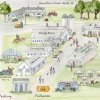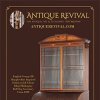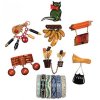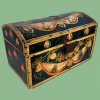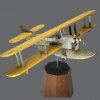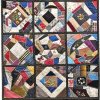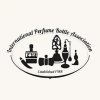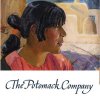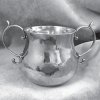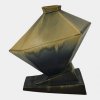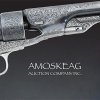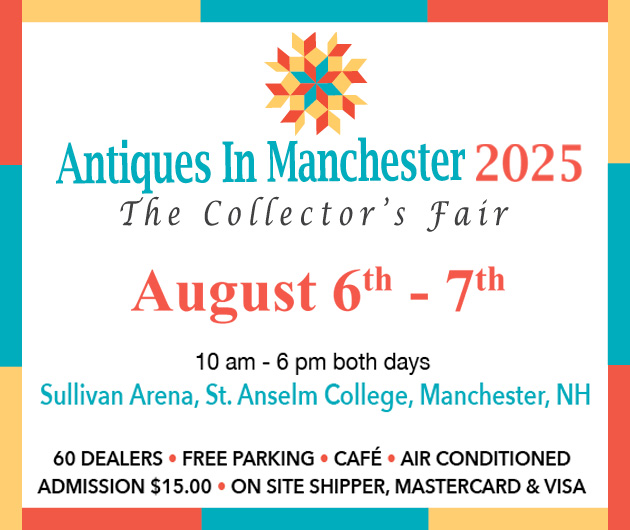Old-Fashioned Auction Brings Forth Treasures
June 24th, 2018
John McInnis Auctioneers, Newbury, Massachusetts
John McInnis Auctioneers’ two-day auction June 23 and 24 had it all: an old-fashioned standing-room-only event on the historic Lower Green in Newbury, Massachusetts, a food truck with a plentiful menu, no reserves, no estimates, no Internet bidding, and iffy cell phone reception, all in place for the dispersion of thousands of objects never seen publicly. Scholars, historians, dealers, and collectors were all on hand.
Two tents were set up on the green, one for day one, and the other, open only on day two, with more of the collection, which included salt hay wagons, 30 six-board chests, dress-making and tailoring objects, ephemera, silver, samplers, kitchenware, and early bottles, to name just a few. It all came from the gatherings of 11 generations of the Plumer-Humphreys-Barton family.

The highlight of the two-day sale was this 1912 Märklin windup tin toy ship Amerika,28" long. It had belonged to Storer Plumer Humphreys (1905-1985), who served as a neurosurgeon in World War II with the Canadian forces, later joining the U.S. forces when the U.S. entered the war. Bidding on the nearly untouched toy opened at $5000 and skipped forward until it sold for $120,750.

This portrait of a girl in a blue dress with her black-and-white spaniel, with a house and what appear to be cemetery gates in the background, sold for $3680. Assuming that she lived in the Plumer house, ascertaining her identity should be an interesting pursuit. McInnis photo.

This circa 1700 dower chest attributed to the Emery shops in Newbury was likely made for Mehetabel Wicom, who was born in Newbury in 1682. It sold to a local buyer for $57,500. The chest is missing its top and its single drawer. It was published in Old-Town and the Waterside (1986) by Peter Benes. It was headed to an area collection.

This copy of English Pilot: The Fourth Book, the first English sea atlas of American waters, was published in 1732. Considered rare, it sold for $9487.50. McInnis photo.
For the most part, the lots across the block were utilitarian objects. Everything had a function in the homestead. Objects had been used carefully and then tucked away. Over the 11 generations, family members worked in a wide variety of professions, and their gleanings reflected that. Among the businesses operated by various members of the Plumer family over the years was a monument business. A carved slate hand warmer in the form of a miniature slant-front desk from that enterprise sold for $115 (includes buyer’s premium). Another example might be the set of teeth that failed to sell.
The condition of most objects was dusty but exceptional. The house and barns were chock full of important historical objects and papers relating to the early settlers of Newbury and Newburyport. One box of ephemera sold for $920. While historical associations and other entities were very interested in the ephemera and historical objects, many were unable to purchase them because of the logistics of gaining board approval for such purchases. They were able to capture some relevant material but were outbid on bigger lots.

The sheet-iron horse-form trade sign, likely for a farrier, brought $2990 from an area dealer.

This tall clock stood on a stairway landing for many years in the Plumer house, and it sold for $1035.

A typed card from the 1930s inside the jointed oak cradle affirmed “Tudor cradle brought to Newbury in 1635 by Francis Plumer,” suggesting that it had survived the Atlantic passage of the Hector. Some observers, however, place its date to about 50 years after Plumer’s arrival and suggest that the maker was Stephen Jaques of Newbury, brother of Plumer’s daughter-in-law Hannah. It realized $17,250 and is headed to the Museum of Old Newbury.

This sampler worked by Mehitabel Thurston, who married Enoch Plumer in 1795, was displayed in a period frame and realized $17,250. Not shown, an 1821 sampler worked by Maria Plumer, daughter of Mehitabel and Enoch, sold for $12,650. McInnis photo.
Linen weaver Francis Plumer arrived on American shores in the spring of 1634 aboard the Hector from London, landing first at Ipswich, and that fall at Parker River in Newbury, Massachusetts. Plumer died there in January 1672 or 1673 after a life of accomplishment. His life’s work included not only his service to the settlement, which later became a town, but he was a farmer and a keeper of the first pub in town. Weaving and textile-related pursuits endured throughout the 11 generations of the family who lived in the Plumer house, which was built around 1700 on the Lower Green in Newbury. It replaced the structure built after Plumer’s arrival. The house passed from one generation to another of Plumers until the Humphreys married into the family shortly after the Civil War. Then it passed to the Bartons in the 20th century. The last of the family, Robert Barton, died in late winter, with no heirs. Proceeds of the auction will be placed in the Barton family trust for distribution to various charities.
 Dan Meader, the gallery director for McInnis Auctions, spent five months organizing the sale in the Plumer-Humphreys-Barton house and barns. He and his crew were amazed at what they found. Piles and piles of documents, letters, newspapers, and books relating to Newbury and Newburyport came to light. Thirty six-board chests opened to reveal ephemera and textiles, among other delights. The textiles were like brand new—those found in the chests were ones that rodents and other creatures had missed. A few chests contained only remnants. At least one Plumer family member was a dressmaker. The dressmaker had packed away the patterns made on newsprint, each with notations of the date, style, and client. The dresses and other articles of clothing were stored inside out, preserving their freshness. Beautiful like-new dresses from the 1840s sold for between $300 and $500 each. Five pairs of early men’s stockings fetched $345.
Dan Meader, the gallery director for McInnis Auctions, spent five months organizing the sale in the Plumer-Humphreys-Barton house and barns. He and his crew were amazed at what they found. Piles and piles of documents, letters, newspapers, and books relating to Newbury and Newburyport came to light. Thirty six-board chests opened to reveal ephemera and textiles, among other delights. The textiles were like brand new—those found in the chests were ones that rodents and other creatures had missed. A few chests contained only remnants. At least one Plumer family member was a dressmaker. The dressmaker had packed away the patterns made on newsprint, each with notations of the date, style, and client. The dresses and other articles of clothing were stored inside out, preserving their freshness. Beautiful like-new dresses from the 1840s sold for between $300 and $500 each. Five pairs of early men’s stockings fetched $345.

The dough box contained a typewritten note from the 1930s stating that the box was used to make bread aboard the Mary and John, the first ship to sail up the Parker River to Newbury in 1635. The dough box sold for $575. The four-drawer flame-birch oxbow chest on which it rests is thought to have been made by Joseph Short (1771-1819) of Newburyport, and it realized $2760.

The horse weathervane that topped one of the two barns on the Plumer-Humphreys-Barton property sold for $1725. An eagle weathervane (not shown) from the other barn brought $1725 from the same phone bidder.
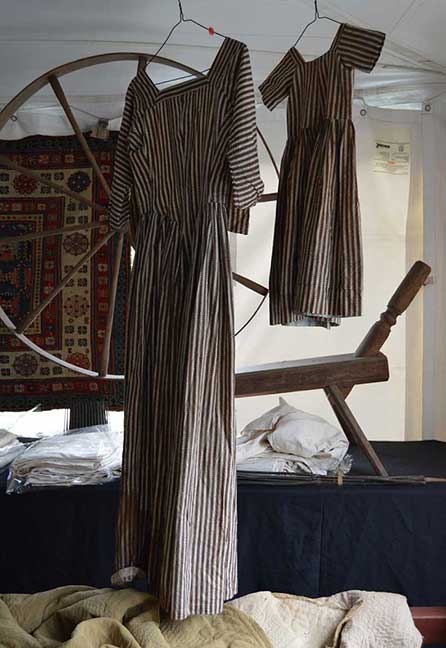
This pair of dresses made by a Plumer family member in the 19th century for a mother and a daughter brought $805. The spinning wheel in the background realized $143.75.
A few days after the sale Meader said that the textiles portion of the sale totaled $40,250 (includes buyers’ premiums). The top lot of a group of Plumer family jewelry from the 18th through the 20th centuries was an approximately two-carat European old-mine-cut diamond set in gold and platinum that sold for $9775. One of the more recent objects in the sale was a 1938 Steinway baby grand piano that had spent its entire life in the house. It was a very good buy at $3450.
For information, check the website (www.mcinnisauctions.com) or call 1-800-822-1417.

The sign is pretty clear—it’s Horace Plumer’s office. He was a lawyer in Newbury, and his well-preserved sign sold for $345. A group of his law books sold for $230. Horace was born on April 26, 1821, and graduated from Dartmouth College in the class of 1840. His brother Daniel Thurston Plumer, who was born May 4, 1819, also graduated from Dartmouth. Daniel’s sign, which had been carefully wrapped, was in brand-new condition. It brought $3565. Daniel’s diplomas from Dartmouth and Harvard brought $161, and a group of medical books sold for $373.75.

Six Connecticut sterling silver cups (four pictured), three by Dunkirk silversmiths and three by Boardman, realized $546.25. McInnis photo.

The highlight of the second day of the auction was a red hay wagon (right) that sold for $4600. At left, the hay wagon with a blue back brought $2300. From the early days of Newbury, salt marsh hay has been gathered from the acres of marshland around Newbury and other coastal areas for mulch and other purposes. Not seen, a tilting cart with several barrels brought $575. McInnis photo.

This exceptional candlestand with delicately formed root legs and red paint sold for $2645. McInnis photo.

This rocking butter churn sold for $460.
Originally published in the September 2018 issue of Maine Antique Digest. © 2018 Maine Antique Digest

